How to Make Shower Water Hotter (Simple Solution)
Author: Omar Alonso | Editor: Omar Alonso
Review & Research: Jen Worst & Chris Miller

Most of us enjoy a warm shower when we wake up. It washes away the haze and prepares us for the day ahead. Or maybe you like a nice hot shower before you go to bed, calming the nervous system to help you fall asleep faster. But how to make shower water hotter is an issue that eludes most of us.
There's no surefire way to ruin the shower experience faster than if the water isn't hot enough or runs cold during your shower. There could be an array of issues causing the problem, and you'll need to diagnose the hot water system to find the problem and restore the hat in your shower water.
How to Make Shower Water Hotter?
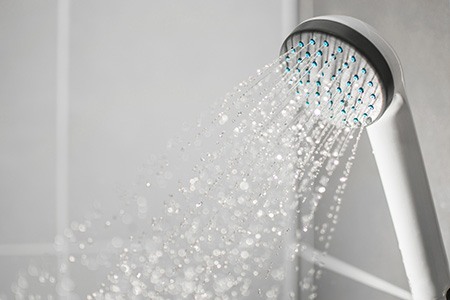
If you want to turn up the heat in your shower water, you can try a few hacks to resolve the problem. If your home has a gas water heater, the problem might be as simple as turning up the thermostat dial or pilot light to increase the temperature. Make sure the pilot light doesn't go out on you.
If your home has an electric water heater, it might be that the unit is past its service life and performing inefficiently. You can try turning up the thermostat dial to see if it resolves the issue; otherwise, you'll need to replace the unit.
A tankless water heater makes a good replacement for an electric water heater. These models allow you to set the water temperature to your exact preference. Look for a model with Energy Star certification by an independent testing authority like Underwriters Laboratories (UL).
What to Do If the Thermostat is Set Too Low
As mentioned, the thermostat is usually the problem with why your shower isn't hot enough. Typically, hot water heaters have a 140-degree setting, but many of them only sit at 120 degrees. Remember to test the new setting after making the adjustment. Give the water some time to flow through the pipes before you decide whether to adjust it a second time.
What to Do If You Have a Faulty Thermostat
If you adjust the thermostat and it doesn't do anything to increase the water temperature in the shower, it's probably dysfunctional or broken. You may have no power to the thermostat, for example. The ideal temperature for hot water in a shower is 120F. You can use a thermometer gun to check the temperature.
If the thermostat is faulty, you must replace it with the same one. Check the owner's manual for a part number or call the manufacturer and give them the heater's model number. When you receive the part, fit it to the heater and see if it makes any difference.
3 Steps to Turn Up the Heat in the Shower
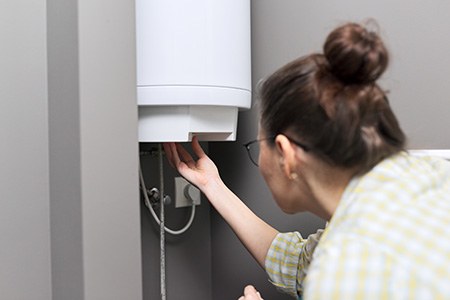
Now let's look at how to make shower water hotter. Follow this simple three-step guide to turn up the shower's water temperature. This is how to get hotter water from a shower.
Step #1 – Start by turning off the power supply to the water heater. You can still use water if the water heater is off, if needed. Flip the switch in the breaker box to turn off the heater. You can usually find a water heater in the basement or garage, which is often where you'll find the breaker box. If you can identify the right circuit for the water heater in the breaker box, call an electrician for assistance.
Step #2 – Find the thermostat on the water heater. Usually, it's located at the bottom of the unit. In some instances, there might be an access panel concealing the thermostat. Use a screwdriver to open the access panel and remove the insulation.
Step #3 – Use the screwdriver to adjust the temperature setting on the thermostat. Usually, there's a screw or dial allowing you to turn it to your preferred setting. Replace the access panel, and you're good to go.
Other Reasons Why the Shower Isn't Hot
As mentioned, other than the thermostat, there could be other reasons why the shower water isn't hot. Here are a few other issues to look for if adjusting the thermostat doesn't work. Fixing any of the following issues may be how to make water hotter in your shower if the typical steps above aren't working.
Incorrect Setting on the Anti-Scald Valve
The anti-scald valve is usually the main reason why your shower isn't hot enough. This valve is also known as the "pressure-balancing shower control valve." The purpose of the anti-scald valve is to prevent the water from getting so hot that it presents a scalding risk.
You'll need to ensure the anti-scald valve is set correctly. Typically, you'll find it behind the cover of the temperature handle in the shower. Use a screwdriver to prize off the cover, and you'll find the anti-scald valve. There's usually a knob you can turn to adjust the anti-scald valve and turn up the temperature.
Damaged Gas Valve
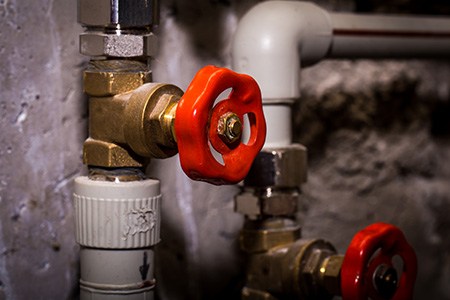
Most gas-powered water heaters experience problems with the gas valve after ten years. If some cases, a worn gas valve can cause the shower to run cold. If you notice a skunk-like or rotten egg smell when using the shower, it is probably the gas valve. Don't run the hot water; call a plumber to replace it immediately. A gas leak presents an explosion risk in the home; running it will fill your home with gas.
Damaged Dip Tube
You might also have a problem with a broken dip tube in the hot water heater. This part is the hollow, long column protruding from the top of the water heater down into the bottom of the tank. Usually, the heater pulls cold water from the tube into the tank to heat it. If the dip tube is broken, it won't heat the water properly. The water mixes in the tank, producing only lukewarm water.
Rusty Shower Pipes
Water, especially hard water, contains mineral deposits such as calcium and chlorine. These minerals build up in the pipe work feeding the water heater. The accumulated deposits may result in inefficient water heating, leading to a lukewarm shower.
You'll need to install a water-softening unit to prevent the mineral deposits from accumulating in the pipework. The water softener exchanges calcium and magnesium for sodium ions in your pipes and water heater. The sodium replaces the other minerals in the water, allowing for faster heating.
Sediment Buildup in the Water Heater Tank
Mineral deposits can also create sediment buildup in the bottom of the water tank. Scale, or "calcium carbonate," builds up when you heat hard water for too long. As a result, you get inefficient water heater operation, leading to a lukewarm shower. One answer for how to make shower water hotter is to remove the blockages stopping the hot water from being delivered.
You can try to remove the sediment yourself by darning the tank and filling it with eight cups of white spirit vinegar. Leave it to sit for six to eight hours, and drain the vinegar from the tank. Flush it with fresh water and drain again. The acidity of the vinegar removes the scale and helps the water heater operate optimally.
Damaged or Dysfunctional Heating Element
Old-model water heaters have a heating element on the top of the unit. If one of them breaks, it leads to the production of lukewarm water. Check the lower and upper heating elements. If they're faulty, replace them. After replacing the elements, test the water; it should run hot. If not, you might have a problem with the thermostat.
Hot Shower Water FAQs
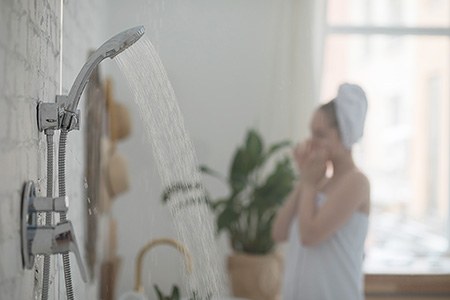
Whenever we talk about setting the temperature of shower water, a bunch of other questions come along beyond just how to make my shower hotter. Let’s cover those now.
How Do I Keep the Shower Water Hotter for Longer?
The most common issue with shower water not being hot enough is that the thermostat needs to be turned up. It's common for homes using hot water heaters to experience cooler conditions in the winter than reduce the operating temperature of the tank.
The cold weather might also make the pipes colder, leading to a lukewarm shower. Turn the thermostat up a few degrees and see if it makes any difference. If the shower is still lukewarm, you might need to replace the thermostat.
What Temperature is Too Hot for the Shower Water?
The optimal temperature for shower water is under 120 °F. If you adjust the thermostat in your water heater, turn it up a little at a time and check the temperature. Typically, temperatures above 140 °F can lead to scalding yourself in the shower.
What Is the Optimal Temperature for Shower Water?
Most dermatologists state the optimal temperature for shower water is between 98 °F and 104 °F. You shouldn't run your shower any hotter than 105 °F., especially if you've removed the shower head flow restrictor.
What Affects the Temperature of the Shower?
If you use other appliances in your home that require water while you're in the shower, it can reduce the temperature., For instance, if you're running the dishwasher or washing machine, it can make the water seems lukewarm in the shower. Flushing the toilet causes an increase in water temperature.
How Long Do You Need to Shower?
Dermatologists agree that you should shower for no longer than five to ten minutes. That's all the time you need to refresh and hydrate the skin. Any longer doesn't have any additional effect on your body, and you're just wasting water.
Key Takeaways to Making Shower Water Hotter
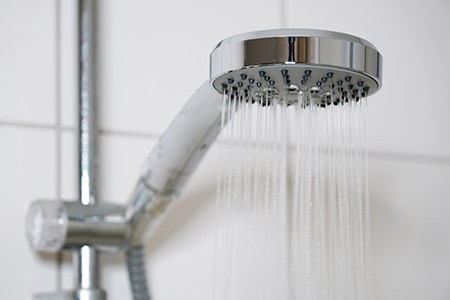
- The most common reason the shower isn't hot is the thermostat.
- You can try turning up the thermostat on the water heater to make the shower hotter.
- If you turn up the thermostat and there's no difference in water temperature, the thermostat might be faulty.
- Gas-powered water heaters might have a broken or worn valve. If that's the case, you'll notice a rotten egg smell when you shower. That's a sign of a gas leak. Call a plumber to fix it ASAP, as a gas leak is a safety risk in the home.
- Most hot water heaters have a service life of 10 to 15 years. If you have an old model, you might need to replace it.
That’s How to Make Shower Water Hotter
We’ve laid out all of the mechanisms you need to investigate if you’re having cold shower problems. But there may not be an issue, especially if you’ve just moved in or the water temperature hasn’t changed. You may simply have decided you want it warmer. We’ve given you three easy steps for how to make shower water hotter above, and you should have no problem going through them yourself.



